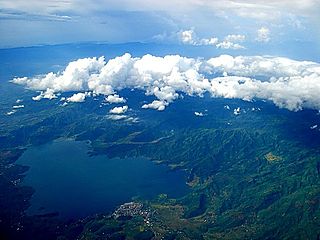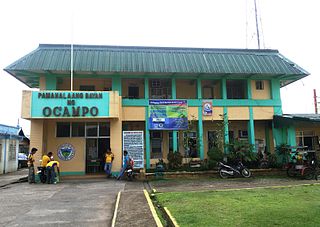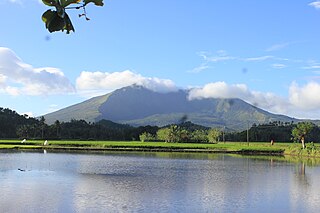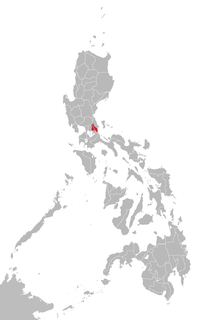Related Research Articles

Camarines Sur is a province in the Philippines located in the Bicol Region in Luzon. Its capital is Pili and the province borders Camarines Norte and Quezon to the northwest, and Albay to the south. To the east lies the island province of Catanduanes across the Maqueda Channel.

Buhi, officially the Municipality of Buhi, is a 1st class municipality in the province of Camarines Sur, Philippines. According to the 2020 census, it has a population of 81,306 people.

Iriga, officially the City of Iriga, is a 4th class component city in the province of Camarines Sur, Philippines. According to the 2020 census, it has a population of 114,457 people.

Ocampo, officially the Municipality of Ocampo, is a 3rd class municipality in the province of Camarines Sur, Philippines.

Lake Buhi is a lake found in Buhi, Camarines Sur in the Philippines. It has an area of 18 square kilometres and has an average depth of 8 metres (26 ft). The lake lies in the valley formed by two ancient volcanoes, Mount Iriga and Mount Malinao. It was created in 1641, when an earthquake caused a side of Mount Asog to collapse. The resulting landslide created a natural dam that blocked the flow of nearby streams. Another theory suggests that it was created by the eruption of Mt. Asog, which is now dormant.

Rinconada Bikol or simply Rinconada, spoken in the province of Camarines Sur, Philippines, is one of several languages that compose the Inland Bikol group of the Bikol macrolanguage. It belongs to the Austronesian language family that also includes most Philippine languages, the Formosan languages of Taiwanese aborigines, Malay, the Polynesian languages and Malagasy.

Remontado, also known as Sinauna, Kabalat, Remontado Dumagat, and Hatang-Kayi, is a Malayo-Polynesian language spoken in Tanay, Rizal, General Nakar, Quezon, Rodriguez, Rizal and Antipolo, in the Philippines. It is one of the Philippine Negrito languages.
The Mamanwa language is a Central Philippine language spoken by the Mamanwa people. It is spoken in the provinces of Agusan del Norte and Surigao del Norte in the Lake Mainit area of Mindanao, Philippines. It had about 5,000 speakers in 1990.
Arta is a highly endangered Negrito language of the northern Philippines.

Dupaningan Agta, or Eastern Cagayan Agta, is a language spoken by a semi-nomadic hunter-gatherer Negrito people of Cagayan and Isabela provinces in northern Luzon, Philippines. Its Yaga dialect is only partially intelligible.
Manide is a Philippine language spoken near the province of Camarines Norte in Bicol region of southern Luzon in the Philippines. Manide is spoken by nearly 4,000 Negrito people, most of whom reside in the towns of Labo, Jose Panganiban, and Paracale.
The Negrito peoples of the Philippines speak various Philippine languages. They have more in common with neighboring languages than with each other, and are listed here merely as an aid to identification.
Inagta Partido is a nearly extinct Bikol language spoken by a semi-nomadic hunter-gatherer Agta (Negrito) people of the Philippines. It is found on Mount Isarog east of Naga City.
Mount Iraya Agta is a Bikol language spoken by a semi-nomadic hunter-gatherer Agta (Negrito) people of the Philippines, east of Lake Buhi in Luzon. It is mutually intelligible with Mount Iriga Agta on the other side of the lake.
Casiguran Dumagat Agta, also known as Dumagat Agta or Casiguran Agta, is an Aeta language of the northern Philippines. It is spoken by around 610 speakers, most of whom live in the San Ildefonso Peninsula, across the bay from Casiguran, Aurora.
Umiray Dumaget Agta is an Aeta language spoken in southern Luzon Island.
Inagta Alabat is a nearly extinct Aeta language spoken in central Alabat Island, Philippines. Inagta Lopez is a dialect spoken in Guinayangan.
Katabangan is an extinct Aeta language that was spoken in the Bondoc Peninsula of Quezon Province, southern Luzon in the Philippines. It is misspelled "Katabaga" in Ethnologue.

The Bikol languages or Bicolano languages are a group of Central Philippine languages spoken mostly in the Bicol Peninsula in the island of Luzon, the neighboring island province of Catanduanes and the island of Burias in Masbate.
Ati (Inati), or Binisaya nga Inati, is an Austronesian language of the island of Panay in the Philippines. The variety spoken in northern Panay is also called Sogodnin. The Ati people also speak Kinaray-a and Hiligaynon.
References
- ↑ Inagta Rinconada at Ethnologue (18th ed., 2015)
- ↑ Lobel, Jason William (2013). Philippine and North Bornean languages: issues in description, subgrouping, and reconstruction (PDF) (Ph.D. dissertation thesis). Manoa: University of Hawaii at Manoa.
- ↑ Reid, Lawrence A. (1994). "Possible Non-Austronesian Lexical Elements in Philippine Negrito Languages". Oceanic Linguistics. 33 (1): 37–72. doi:10.2307/3623000. hdl: 10125/32986 . JSTOR 3623000.